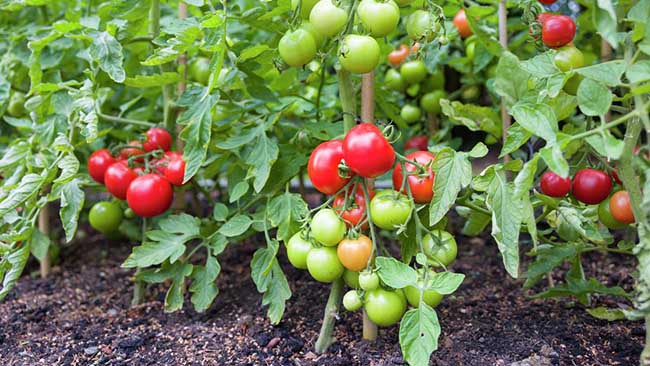Love growing tomatoes? Almost every gardener leaves some space for tomatoes. Once you get to taste the freshness of homegrown tomatoes, you’ll know why you must plant some.
Homegrown tomatoes are sweet, luscious, and sharp as opposed to most watery tomatoes in supermarkets.
While tomato growing is fun, there are a few problems that farmers face. Problems vary from the tomato plant not setting a fruit to multiple tomato diseases.
Keep reading below as I discuss common problems when growing tomatoes.
Blossom End Rot
Blossom End Rot (BER) is a problem that makes the tomato bottom show ugly black patches. This is by far the most common problem facing tomatoes in gardens, greenhouses, home hardens, and especially tomatoes growing in containers.
The problem appears as dry, dark brown/black, and leathery near or at the fruit bottom. On a few occasions, BER can occur on the inside and the fruit side. When it occurs inside, the BER remains hidden until the fruit is sliced open.
Such tomatoes tend to ripen first than others with the spot sunken.
The major cause of BER is the lack of enough calcium in the soil. It can also be due to low pH levels. Tomatoes need at least 6.5 pH to grow.
Tomato Leaves Turning Yellow
Tomato yellow leaves are another common problem that affects tomatoes. There are various causes of yellow leaves: overwatering, change in environment, nutrient deficiency and various diseases cause the tomato leaves to turn yellow. Most diseases affecting tomatoes occur along with other symptoms like wilting and leafy spots.
If you need more information about this problem, I would suggest you follow Briana Yablonski from backyardgardenersnetwork.org, she did a great job of addressing why are tomato leaves turning yellow in this article.
Fruit Cracking
Tomato cracking is another common problem when they don’t get the best conditions. Most of these cracks start from the stem and are usually called radial. They radiate from the stem and end up affecting the fruit. Other types of cracks form rings around the stem and fruits.
The major cause of tomato cracking is inconsistent water supply to the plant. When you don’t water your tomatoes frequently, they will develop cracks.
But that’s not always the case, tomatoes can also crack due to excessive moisture that leads to rapid growth. This usually occurs after a prolonged period of high temperatures.
Big temperature differences between daytime and nighttime can also cause cracking.
While you cannot prevent all types of cracks, you can lessen the effects. This is done through mulching and maintaining a constant water supply. Make sure you also use an adequate fertilizer program.
Misshapen Fruit
You can also have tomato fruits come in poor shapes. This is a common problem among garden farms. Tomatoes develop poor shapes when temperatures are too low. Low temperatures lead to a ridged fruit shape.
The ideal temperature for tomatoes is above 60 degrees F. Make sure you plant tomatoes when temperatures are high.
However, some varieties of tomatoes are prone to produce misshapen fruits. A good example is the older heirloom variety and the larger beefsteak types.
Catfacing
This is another common problem that affects the shape of the fruit. The fruit usually becomes malformed in an irregular shape. It creates brown scars at the blossom end. The scars might sometimes run on the fruit sides.
You’ll see fruit with deep crevices. It’s different from BER where you see sunken parts with dark brown bottoms. When it’s severe, catfacing makes the fruit bottom appear turned inside out.
The problem is common in cooler temperatures, affecting the earliest harvested fruits. However, fruits with such issues are still edible. You just need to cut out the affected part.
This is a problem caused by cool temperatures and early pollination. You can try resistant varieties and plant them later in the season.
Leaf Rolling
Ever seen your tomato plant with leaves rolling inward? If yes, then this is a common problem called leaf rolling. The condition can be mild or severe. It usually occurs once plants form a heavy fruit load.
The problem usually starts with older leaves but can sometimes affect the entire plant. It’s not a serious condition and does not affect fruit production.
When it occurs, try to avoid frequent pruning. You can also try planting tomatoes in well-drained soils.
Uneven Ripening
Lastly, we look at uneven ripening which is common in tomatoes. This happens due to high nitrogen levels, high temperatures, low potassium, infections, etc.
You can reduce this by maintaining proper balance when feeding your tomatoes.
